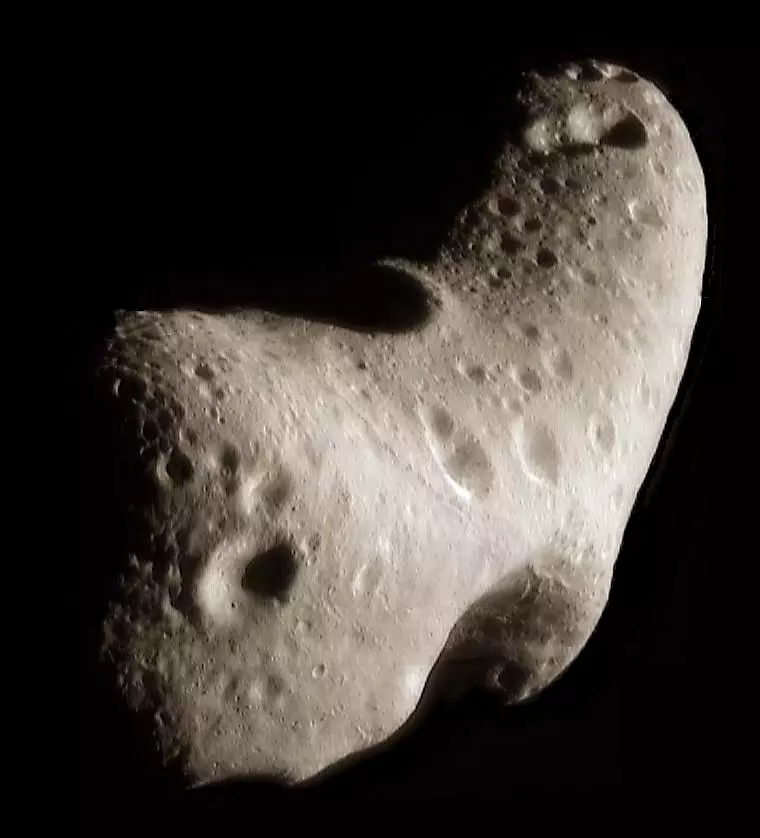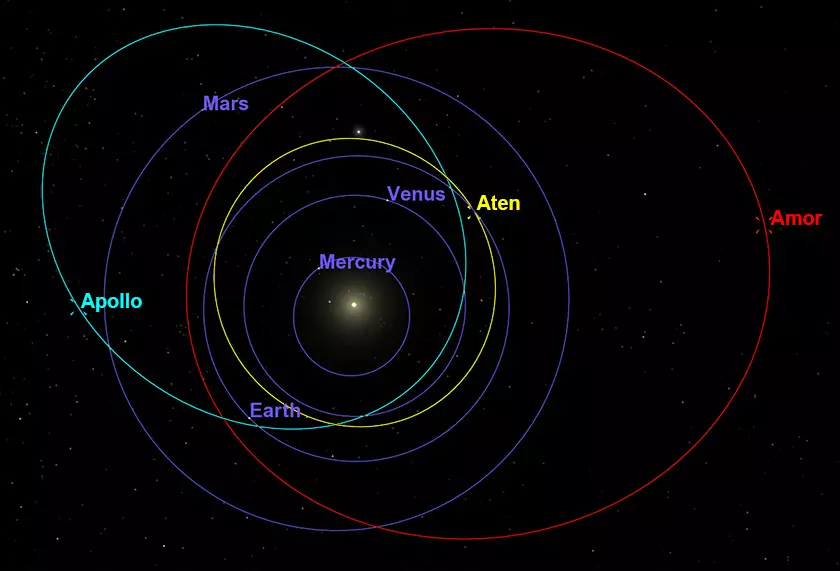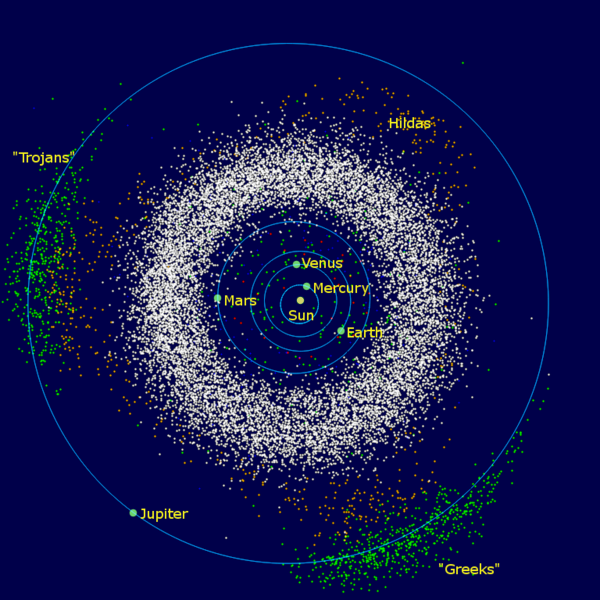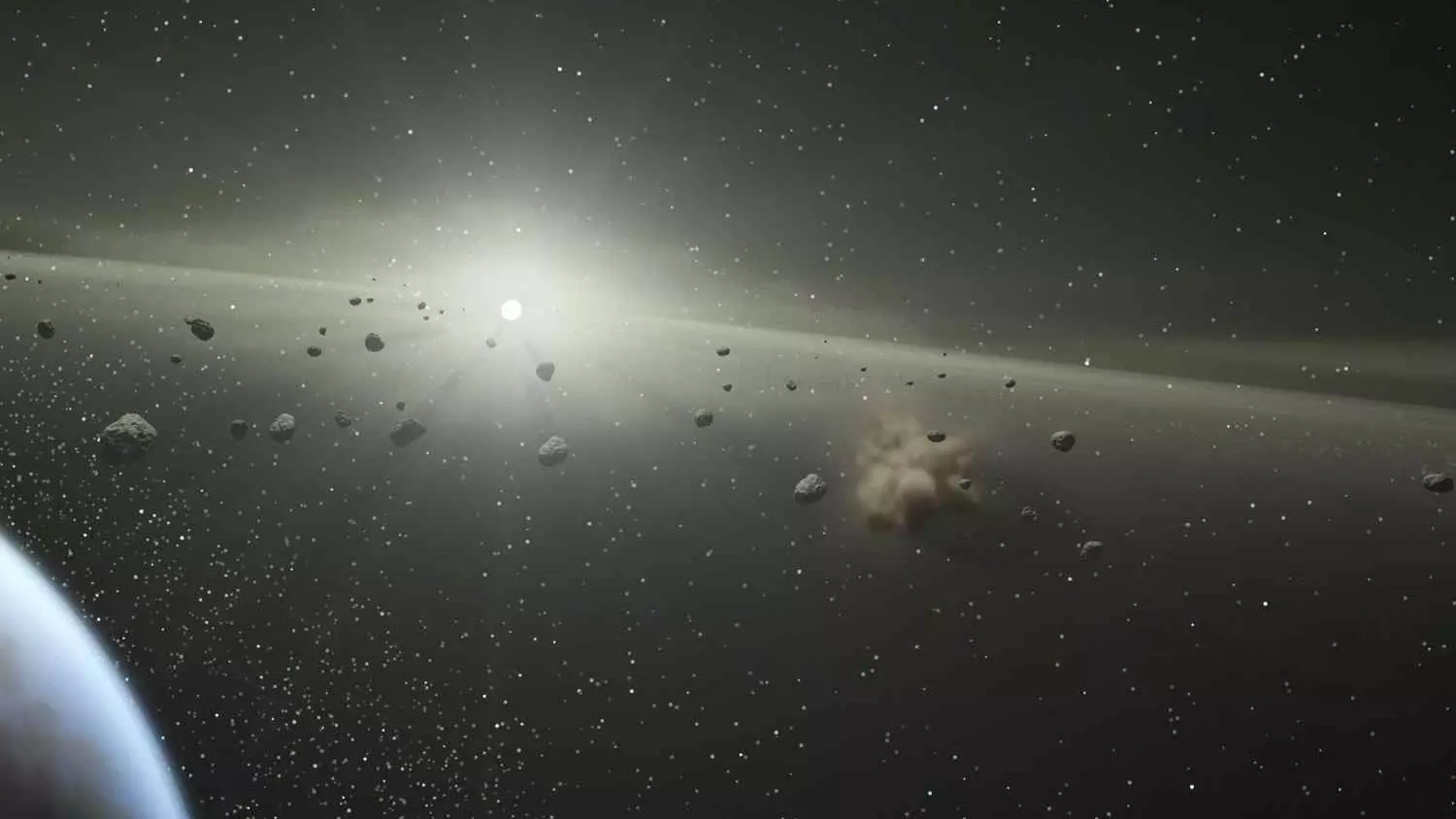[Excerpted from Worlds of Creation: Asteroids]
Main Belt
Another way to classify asteroids is by their orbit. The first four asteroids discovered all belong to the main belt. The main belt refers to asteroids that orbit in between Mars and Jupiter.
Although the term “asteroid belt” may evoke images of a densely-packed region of boulders as depicted in movies like “The Empire Strikes Back,” in reality, the space between asteroids is enormous. If you were standing on one asteroid, you probably would not see another one.
Yes, there are hundreds of thousands of asteroids, most of which are in the main belt. But space is vast.
Most main belt asteroids orbit prograde—the same direction as the planets—with relatively low inclinations—variation from the flat plane the planets form—though generally higher than the planets. However, some have inclinations of around 90 degrees, and hence orbit nearly perpendicular to the plane of the planets. A very few asteroids have inclinations greater than the 90 degrees, and hence orbit retrograde—the opposite direction around the sun.
If you examine the average distance from the sun at which main belt asteroids orbit, you will find there are certain distances that asteroids seem to avoid. For example, there are virtually no asteroids that orbit the sun at an average distance of 2.5 AU.
The culprit is Jupiter. Jupiter is more massive than the rest of the planets combined. Hence, its gravity has a strong effect on the orbits of asteroids. Asteroids cannot orbit at 2.5 AU [distance from the Earth to the sun] for any length of time because they would be in an unstable 3:1 orbital resonance with Jupiter, and would eventually be perturbed into a different orbit. Likewise, there are gaps at 2.82 AU, 2.95 AU, and 3.27 AU, each corresponding to a resonance with Jupiter. These are called the Kirkwood gaps.
Additionally, there are several families of asteroids that are not confined to the main belt.
Amor class asteroids have an orbit that come close to, but do not cross Earth, and have a perihelion distance less than 1.3 AU. As such, Amor asteroids orbit either entirely within the orbit of Mars, or (more commonly) cross the orbit of Mars. A Mars-crossing orbit does not necessarily mean that the orbits actually intersect, since they are generally in different planes.
The family is named after its archetype asteroid Amor. Another notable Amor class asteroid is Eros. We have high-resolution images of Eros from the NEAR Shoemaker space probe. After analyzing Eros from orbit, the probe landed on Eros – an amazing technological feat!

Apollo class asteroids are one of two groups of Earth-crossing asteroids. Apollo asteroids have an average distance from the sun that is greater than that of Earth. Consequently, Apollo asteroids have an orbital period greater than one year. However, their elliptical orbit at times brings them closer to the sun than the Earth. The group is named after the prototype.
Aten class asteroids are also Earth-crossers, but their average distance from the sun is less than that of Earth. Consequently, they have an orbital period of less than one year. But the aphelion of an Aten asteroid is slightly farther from the sun than Earth. They are named after the asteroid Aten, the first of its class to be discovered. Earth-crossing asteroids are closely monitored since a small fraction of them actually pass relatively close to Earth at times. However, none will impact the Earth within the foreseeable future.
Atira class asteroids orbit entirely within Earth’s orbit. Named after the first discovered member, these are the least populated family. There are only 22 known Atira asteroids. All but one cross the orbit of Venus; the exception is entirely inside the orbit of Venus. Half of the known Atira asteroids also cross the orbit of Mercury.
Trojans
The Amor, Apollo, Aten, and Atira asteroid groups all orbit closer to the sun than the members of the main belt. But there are also asteroids that orbit beyond the main belt, and in fact share an orbit with Jupiter. These are the Trojan asteroids. They orbit either sixty degrees ahead of Jupiter, or sixty degrees behind.
At such locations, a Trojan asteroid forms an equilateral triangle with the sun and Jupiter. These two locations are Lagrangian points. They are called L4 and L5 and are the only stable positions where one object may permanently share the orbit of another much more massive object.[4] Over 7000 Trojan asteroids have been discovered.

The term “Trojan” comes from the Trojan War of Greek mythology. Just as the Greeks hid inside the Trojan horse, so Trojan asteroids “hide” in the orbit of Jupiter. The first Trojan asteroid, Achilles, was discovered in 1906. Two additional Trojans were discovered within a year: Hektor, and Patroclus.
Hektor is extremely elongated in shape—over twice as long as its width. It may be a contact binary: two asteroids that are stuck together and rotate around their common center of mass. It is the largest Trojan asteroid. Hektor also has a small 7-mile diameter moon named Skamandrios. Yes, asteroids can have moons.
It is customary to name Trojan asteroids after heroes of the Trojan War. Furthermore, those in the L4 group (those that orbit 60 degrees ahead of Jupiter) are named after heroes from the Greek camp, and those in the L5 group (which trails Jupiter) are named after heroes in the Trojan camp.
There are two exceptions to this Greek/Trojan camp rule: Hektor and Patroclus were named before the second custom was in place, and are in the opposite camp. Hence, each camp has one “spy” from the other side. Curiously, 65% of Trojans are in the leading “Greek” camp, with only 35% in the trailing “Trojan” camp. The reason for this is unknown.
The existence of Trojan asteroids sharing Jupiter’s orbit led astronomers to ask if other planets could have Trojan asteroids sharing their orbit. Could there be a “Mars Trojan” or a “Venus Trojan?” The answer is yes, however, they are very few.
Mars has 9 known Trojan asteroids. Earth has one and so does Venus. Neptune has 24 Trojans, and Uranus has two. Mercury has none, and amazingly, neither does Saturn. Ceres and Vesta each have a Trojan. So, even asteroids can have Trojan asteroids, although it is not common. If the name of the planet is not specified, the term “Trojan asteroid” refers to a Jupiter Trojan.
Hilda class asteroids
…are also heavily influenced by the gravity of Jupiter. They orbit the sun in elliptical paths at an average distance of roughly 4.0 AU. This puts them beyond the main belt, but inside the orbit of Jupiter, such that they are in a 3:2 orbital resonance with Jupiter.
Their elliptical path brings these asteroids within the main belt at perihelion, and very near the orbit of Jupiter at aphelion. However, their orbit is synchronized such that when a Hilda asteroid is at aphelion, it will always be very near a Jupiter Lagrangian point. It will either be near L4 or L5 to temporarily join the Trojans, or on the opposite side of the sun near L3. In fact, each orbit brings a Hilda asteroid to the next Lagrangian point in the sequence: L5, then L4, then L3, and then back to L5. Consequently, at any given time, the Hilda asteroids appear to form an enormous triangle connecting these three Lagrangian points.
Roughly 4000 Hilda class asteroids have been discovered. They are named after their archetype, which was discovered in 1875.







